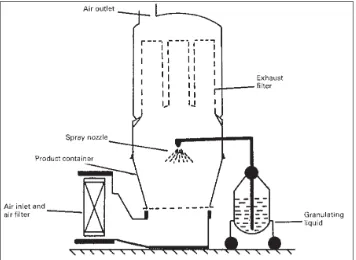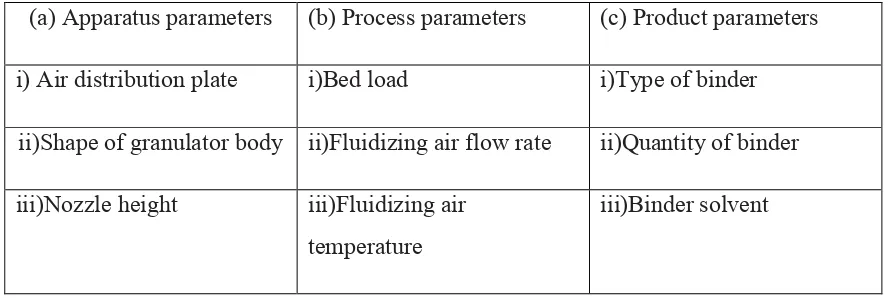UNIVERSITI TEKNIKAL MALAYSIA MELAKA
This report submitted in accordance with requirement of the Universiti Teknikal Malaysia Melaka (UTeM) for the Bachelor Degree of Manufacturing Engineering
(Process Engineering)
by
MUHAMMAD FAIZ BIN MOHD B050810247
891224-11-5301
FACULTY OF MANUFACTURING ENGINEERING 2012
UNIVERSITI TEKNIKAL MALAYSIA MELAKA
1. Laporan PSM adalah hak milik Universiti Teknikal Malaysia Melaka dan penulis. 2. Perpustakaan Universiti Teknikal Malaysia Melaka dibenarkan membuat salinan
I hereby, declared this report entitled “Physical Characterization of Urea-Lignin Fertilizer Granule” is the results of my own research except as cited in references.
Signature : ……….
Author’s Name : Muhammad Faiz Bin Mohd
Date : 29 June 2012
This report is submitted to the Faculty of Manufacturing Engineering of UTeM as a partial fulfillment of the requirements for the degree of Bachelor of Manufacturing Engineering (Manufacturing Process). The members of the supervisory committee are as follow:
………
(Principal Supervisor)
………
i Kajian ini adalah untuk menjalankan kajian mikrostruktur baja urea mengikat granul menggunakan lignin dengan berat yang berbeza. Mikroskop Elektron Pengimbasan (SEM) akan dikenakan sebagai peralatan analisis yang utama. SEM adalah sejenis mikroskop electron yang memaparkan imej sampel menerusi proses imbasan menggunakan alur elektron yang bertenaga tinggi. Skop kajian akan merangkumi urea sintetik dan lignin yang boleh didapati secara komersil. Granul dihasilkan menggunakan ‘extruder’. Lignin diperolehi daripada sumber yang boleh diperbaharui terutamanya seperti pokok-pokok, tumbuhan-tumbuhan, dan tanaman pertanian. Lignin adalah bebas toksik dan ciri-ciri ini menjadikan ia satu produk yang sangat serba boleh untuk kegunaan dalam industri dan industri pemprosesan makanan. Lignin adalah pengikat yabg sangat berkesan dan mesra ekonomi yang bertindak sebagai ejen yang mengikat atau sebagai gam kepada pelet baja.
ii This research is to conduct microstructure study on extruded urea fertilizer granule bind with lignin of various weight concentrations. Scanning Electron Microscope (SEM) will be used as the main analysis equipment. SEM is a type of electron microscope that images a sample by scanning it with a high energy beam of electron. The scope of study will cover on synthetic urea and lignin which are commercially available. The granule is produced using extruder. Lignins are derived from an abundant and renewable resource notably trees, plants, and agricultural crops. Lignin is nontoxic and these characteristics of it make it an extremely versatile product for use in industrial and food processing industries. Lignin is a very effective and economical adhesive acting as a binding agent or as glue to the pellets of the fertilizers.
iii To my beloved parents who have always encouraged me to do my best and supported
iv Alhamdulillah, thanks to every individuals that have been together supporting me for this final year project. Endless appreciation to my principal supervisor, Prof. Madya Ir. Dr. Sivarao Subramonian and my co-supervisor, Mr. Mohd Fairuz Bin Dimin@ Mohd Amin for their encouragement and support and spending so much time to help, guide and brainstorm ideas and also for their assistance in the preparation of this manuscript. Thank you very much also for my classmates in helping me with this report especially. Thanks also to the lecturers at Faculty of Manufacturing for the guidance and patience for me all this while. I am very grateful to Him as He blessed me with such wonderful teachers and friends. Last but not least, thank you very much to my family members for always being a faithful supporters to me all the time.
vii 2.1 Apparatus, process and product variables influencing fluidized bed
granulation
8
3.1 Samples prepared 25
3.2 Temperature setting for each sample 27
ix HFS - Horizontal Feed Screw
NH3 - Ammonia
NH4+ - Ammonium
SEM - Scanning Electron Microscope VPS - Vertical Pre-compression Screw
LIST OF ABBREVIATION, SYMBOLS AND
1
CHAPTER 1
INTRODUCTION
1.1 Background of Study
2
1.2 Problem Statement
3
1.3 Objective
The goals of this project are:
(a) To conduct microstructure study on urea fertilizer granule bind with lignin using various weight concentration.
(b) To study whether lignin can be used as a good binder to the fertilizer.
1.4 Scope of the Project
The scopes of the project are:
(a) Microstructure study of urea fertilizer granule bind with lignin using Scanning Electron Microscope (SEM).
4
CHAPTER 2
LITERATURE REVIEW
2.1 Urea Fertilizer
Urea is a very commonly found element in fertilizer. It consists of such great importance to the agriculture industry as a nitrogen-rich fertilizers that will enhance the natural fertility of the soil. In detail, it will actually replace the chemical elements taken from the soil by harvesting, grazing, leaching or erosion. Urea is commonly sold for fertilizer in 2 - 4 mm diameter granules. These granules are formed by spraying molten urea onto seed granules that are supported on a bed of air. Among the advantages of urea fertilizer includes costs which are cheap and it is immediately available due to the abundance of it in market. Although urea is naturally obtained, all urea fertilizers in market today are produced or synthesized in factories. On a commercial basis, urea is available as prills or as a granulated fertilizer (Copplestone and Kirk, n.d).
5 Urea fertilizer does possess some advantages such as it can be applied to soil as a solid or solution or to certain crops as a foliar spray. It also involves little or no fire or
Urea is made from ammonia and carbon dioxide. The ammonia and carbon dioxide are fed into the reactor at high pressure and temperature, and the urea is formed through reaction of ammonia and carbon dioxide The use of urea in single line urea granulation plants nowadays have increased rapidly every year. With increasing environmental awareness more and more attention is paid to the ammonia emissions from such plants. Due to the size of the plants there is a release of a considerable amount of ammonia from a single source or location, which raises concerns for the neighbours of such installations. On the other hand urea producers want to benefit from the economics of scale and are looking for ever increasing single line capacities for which they want to obtain operating permissions from regulatory authorities. Most of the ammonia is used on site in the production of urea (Potthoff, 2002).
6
2.2 Fluidized Bed Granulator
A fluidized bed is a bed of solid particles with a stream of air or gas passing upward through the particles at a rate great enough to set them in motion. As the air travels through the particle bed, it imparts unique properties to the bed. A granulator which receives the seed granules at one end and discharges enlarged granules at the other as molten urea is sprayed through nozzles. Fluidized bed granulator main function is to do the granulation process. Granulation process by this granulator is important to prevent segregation of the constituents of the powder mix. Segregation is due primarily to differences in the size or density of the components of the mix, the smaller and/or denser particles concentrating at the base of a container with the larger and/or less dense ones above them. An ideal granulation will contain all the constituents of the mix in the correct proportion in each granule, and segregation of the ingredients will not occur. It is also important to control the particle size distribution of the granules because, although the individual components may not segregate, if there is a wide size distribution the granules themselves may segregate. This machine is also important in order to compact the mix. Some powders are difficult to compact even if a readily compactable adhesive is included in the mix, but granules of the same formulation are often more easily compacted and produce stronger tablets. This is associated with the distribution of the adhesive within the granule and is a function of the method employed to produce the granule. Often solute migration occurring during the post-granulation drying stage results in a binder-rich outer layer to the granules. This in turn leads to direct binder bonding, which assists the consolidation of weakly bonding materials (Summers and Aulton, n.d.).
7
bed of particles.The fluid causes the primary powder particles to adhere when the droplets and powders collide. Escape of material from the granulation chamber is prevented by exhaust filters, which are periodically agitated to reintroduce the collected material into the fluidized bed. Sufficient liquid is sprayed to produce granules of the required size, at which point the spray is turned off but the fluidizing air continued. The wet granules are then dried in the heated fluidizing airstream. Fluidized bed granulation has many advantages over conventional wet massing. All the granulation processes, which require separate equipment in the conventional method, are performed in one unit, saving labour costs, transfer losses and time. Another advantage is that the process can be automated once the conditions affecting the granulation have been optimized
(Summers and Aulton, n.d.).
8
On the downside, the fluidized bed granulator is initially expensive and optimization of process parameters affecting granulation needs extensive development work, not only during initial formulation work but also during scale-up from development to production.
Table 2.1: Apparatus, process and product variables influencing Fluidized Bed Granulation (Summers and Aulton, n.d.)
(a) Apparatus parameters (b) Process parameters (c) Product parameters
i) Air distribution plate i)Bed load i)Type of binder
ii)Shape of granulator body ii)Fluidizing air flow rate ii)Quantity of binder
iii)Nozzle height iii)Fluidizing air
temperature
9
2.3 Scanning Electron Microscope (SEM)
Scanning Electron Microscope or SEM is a type of electron microscope that images a sample by scanning it with a high-energy beam of electrons in a raster scan pattern. SEM can produce very high-resolution images of a sample surface. The microscopes are great for seeing images "up close" that otherwise would be non-existent for the person viewing. SEMs are also easy to operate with the proper training. The scanning electron microscope has many advantages over traditional microscopes. The SEM has a large depth of field, which allows more of a specimen to be in focus at one time. The SEM also has much higher resolution, so closely spaced specimens can be magnified at much higher levels. Because the SEM uses electromagnets rather than lenses, the researcher has much more control in the degree of magnification. All of these advantages, as well as the actual strikingly clear images, make the scanning electron microscope one of the most useful instruments in research today (Schweithzer, 2003).
There is arguably no other instrument with the breadth of applications in the study of solid materials that compares with the SEM. The SEM is critical in all fields that require characterization of solid materials. While this contribution is most concerned with geological applications, it is important to note that these applications are a very small subset of the scientific and industrial applications that exist for this instrumentation. Most SEM's are comparatively easy to operate, with user-friendly "intuitive" interfaces. Many applications require minimal sample preparation. However, SEM does also possess some disadvantages and limitations such as Samples must be solid and they must fit into the microscope chamber. Maximum size in horizontal dimensions is usually on the order of 10 cm, vertical dimensions are generally much more limited and rarely exceed 40 mm. For most instruments samples must be stable in a vacuum on the order of 10-5 - 10-6 torr. Samples likely to outgas at low pressures (rocks saturated with
10 insulating samples for study in conventional SEM's, unless the instrument is capable of operation in a low vacuum mode (Swapp, 2006)
11
2.4 Lignin

